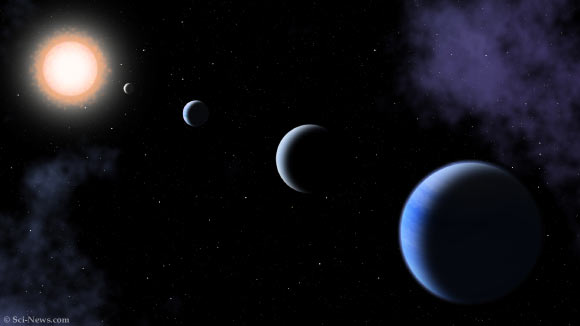TESS Finds Four-Planet System around Sun-Like Star | Astronomy – Sci-News.com
Astronomers using the Transiting Exoplanet Survey Satellite (TESS) have found four exoplanets — a hot super-Earth and three sub-Neptunes — orbiting the bright, Sun-like star HD 108236. A paper detailing the discovery will be published in the Astrophysical Journal.
HD 108236 is a 5.8-billion-year-old main-sequence star of spectral and luminosity type G3V.
The star is located approximately 211 light-years from the Earth in the southern constellation of Centaurus.
Otherwise known as TIC 260647166, TOI-1233, and HIP 60689, it is 11% smaller than our Sun and 15% less massive.
HD 108236 hosts a planetary system of at least four large planets: HD 108236b, c, d and e.
The innermost planet, HD 108236b, is a hot super-Earth with a radius of 1.6 times that of the Earth.
It has a period of 3.9 days, making it the hottest known planet in the HD 108236 system with an estimated temperature of 826 degrees Celsius (1,519 degrees Fahrenheit).
The outer planets, HD 108236c, d and e, are sub-Neptunes with radii 2.1, 2.7, and 3.1 Earth radii and periods 6.2, 14.2, and 19.6 days, respectively. Their temperatures are 659, 435, and 363 degrees Celsius (1,218, 815, and 685 degrees Fahrenheit), respectively.
The masses of the four planets are about 5, 7, 10, and 13 times that of the Earth, respectively. Hence, HD 108236b is likely a dense, rocky planet, whereas sub-Neptunes have hydrogen and helium upper layers.
“The transiting planets b, c, d, and e orbit the host star on orbits with semi-major axes of 0.05, 0.06, 0.11 and 0.14 AU, respectively,” MIT astronomer Tansu Daylan and his colleagues wrote in the paper.
“Compared to our Solar System, the discovered planets orbit rather closer to their host star, HD 108236, forming a closely-packed, compact multiplanetary system.”
The astronomers used TESS data as well as ground-based followup data to validate the planetary nature of the transits detected by TESS.
“HD 108236 is the brightest Sun-like (G-type) star and one of the brightest stars on the sky to host at least four transiting planets,” the researchers wrote.
“It is also the first multiplanetary system delivered by TESS with four validated transiting planets.”
“HD 108236 offers an excellent laboratory for studying planet formation and evolution as well as atmospheric characterization while controlling for the stellar type and age,” they added.
“The sub-Neptunes HD 108236c, d, and e will be favorable targets for atmospheric characterization via transmission spectroscopy with the future James Webb Space Telescope and the NASA/ESA Hubble Space Telescope.”
“The brightness of the host, its similarity to the Sun and the potentially yet-unknown outer companions makes the system a high-priority target for characterization.”
_____
Tansu Daylan et al. 2020. TESS discovery of a super-Earth and three sub-Neptunes hosted by the bright, Sun-like star HD 108236. ApJ, in press; arXiv: 2004.11314






